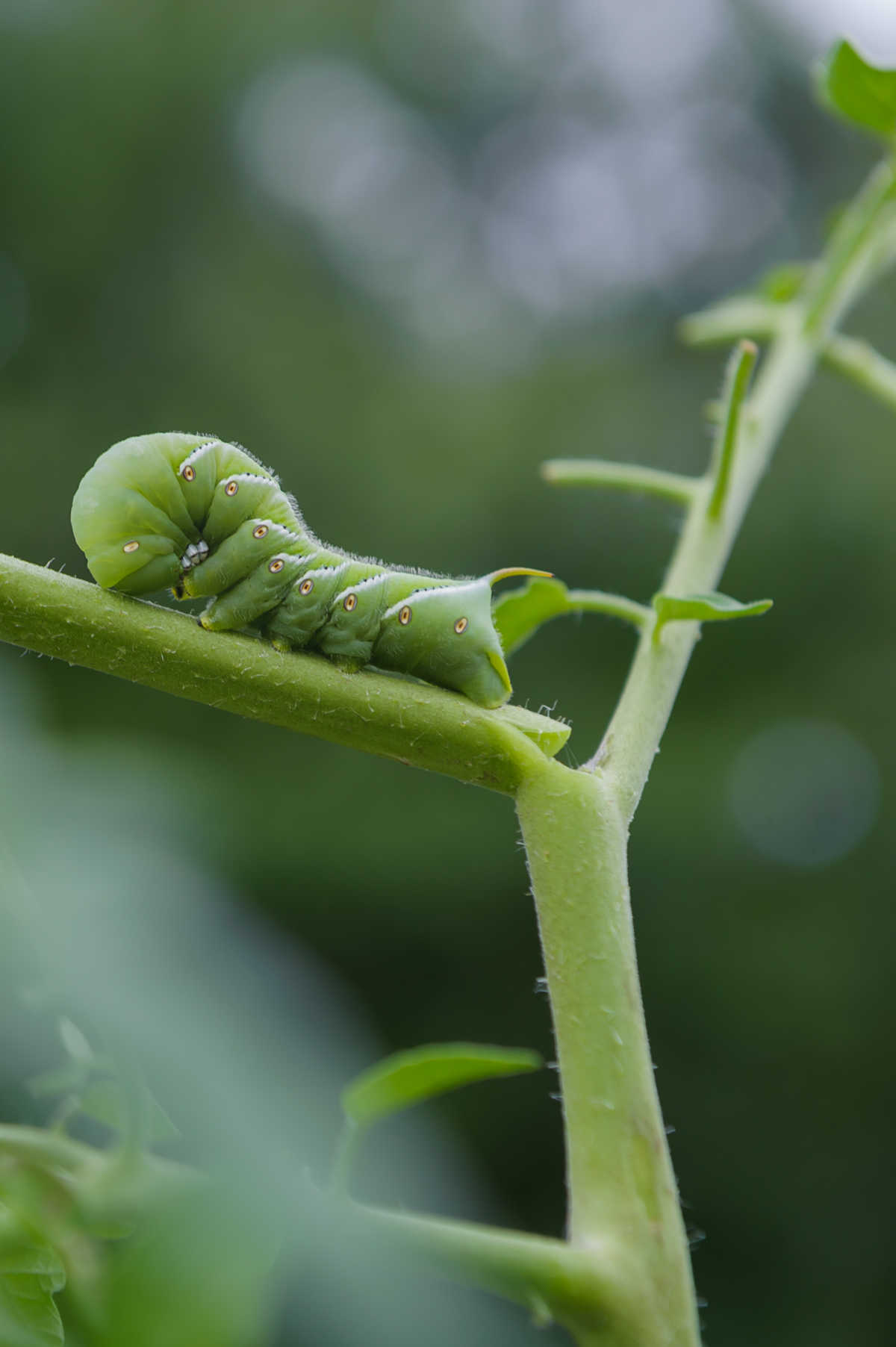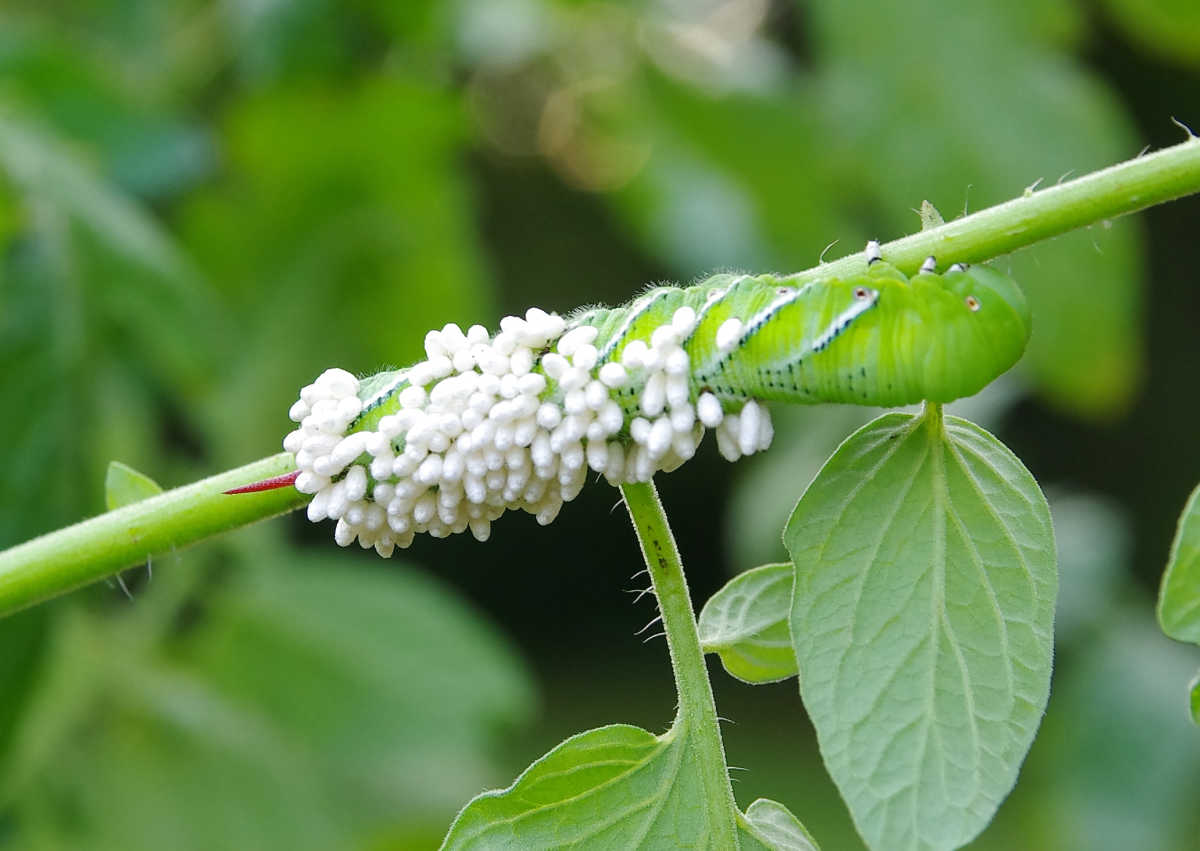The tobacco hornworm is a voracious eater that can do a great deal of damage in a flower or vegetable garden.
It is a pest in the family Solanaceae. The tobacco hornworm is quite commonly seen in the southern United States, especially the Gulf Coast States. Its range extends northward as far as New York.
Caterpillars in this family are known as hornworms, due to a body shape that looks like a worm, and the presence of a small, pointed “horn” at their posterior end.

Tobacco Hornworm – (Manduca sexta) in my garden
I recently decided to prune the dead flowers from my buddleia (butterfly bush) the other day. It was attracting butterflies like crazy, but most of the flowers were long dead.
I thought pruning it would give it a chance to form new flowers before fall and attract even more butterflies.
As I started pruning I noticed that many of the stems were completely clean of leaves. I didn’t think much about it at first but just pruned behind the bare stems and moved on.
But, lo and behold, it did not take me long to discover just WHY my stems were so bare. The bush was playing host to a huge tobacco hornworm caterpillar.
He was just as happy as anything in his all you can eat buffet.
 You cannot tell from the photo, but this caterpillar was at least 4 inches long and the diameter of a good sized man’s middle finger.
You cannot tell from the photo, but this caterpillar was at least 4 inches long and the diameter of a good sized man’s middle finger.
In spite of the common name of the caterpillar – tobacco hornworm, they are often found on many other plants including tomato plants, as well as horse-nettles, nightshades, and other members of the tomato and potato family.
Also, as it turned out for me – my butterfly bush!
Are tobacco hornworms poisonous?
One would think that a critter this large – over 4 inches long – might be a danger to you or someone in your family. They also have a ferocious looking hook on the end of their body that looks dangerous
In actual fact, in spite of their fierce look, manduca sexta cannot sting and are harmless to humans.
Share the post about manduca sexta on Twitter
What is that big green worm in your tomato patch that is eating all the leaves? Is it a tobacco hornworm, or a tomato hornworm? Find out on The Gardening Cook. #manducasexta #tobaccohornworm Click To TweetTobacco hornworm life cycle
Tobacco hornworms have a life cycle similar to that of butterflies. They undergo a complete metamorphosis, from egg to larva to pupa to adult in about 30 days under normal summer temperatures. Cooler temps may extend this time to about 35-48 days.
You are most likely to encounter the larval stage of the insect – the hornworm. It resides on host plants during the day when gardeners are out and about and can cause significant damage to plants and crops.
Eggs of Manduca sexta are laid on leaves of host plants and hatch in 1-3 days. They are 1 mm in diameter and greenish in color.
Tobacco hornworm caterpillars are voracious feeders. They will strip entire plants of leaves quickly if not found and removed. They can cause quite a bit of damage to tobacco, tomato and potato crops.

Caterpillars and moths
The adult stage of tobacco hornworm – manduca sexta – is a moth with a heavy body. The moth is known as Carolina sphinx moth, a hawk moth or hummingbird moth.
The caterpillars can measure 45-60 mm in length and the adult moths, as expected, can have a wing span of about 100 mm.
Female moth can produce as many as 1000 eggs in her lifetime, which is short – just a few weeks.
Tobacco hornworm vs tomato hornworm
The Tobacco hornworm is closely related to another large caterpillar – the tomato hornworm (Manduca quinquemaculata). Both are often kept as pets by children because of their sizes.
Tobacco hornworm caterpillars have white stripes with black margins and a red horn.
Tomato hornworm caterpillars have V-shaped marking and a blue horn or black horn.

There are also differences in the spots on the abdomen. The tobacco hornworm has six orange spots, while the tomato hornworm has only five.
Controlling tobacco hornworm
If the caterpillars are noted in your garden, hand picking and destruction is an effective way to reduce the population.
If you grow tobacco, tomato or potato plants be on vigilant. Don’t make the common gardening mistake of not inspecting and looking for any signs of feeding damage.
This can be a challenge, since the caterpillars themselves are green, as is their host plant.
By the time you notice them, your plant might be stripped of its leaves, as my butterfly bush was!
Crop rotation can be a big help in preventing all types of pests, including tomato hornworm.

Enemies of tobacco hornworm
The tobacco hornworm has several natural enemies such as birds and small animals.
Insects such as wasps, lady beetles and parasitoid wasps all use them as a food source. Parasitic braconid wasp lay their eggs in the hornworm’s body.
As the small wasps grow, they spin white cocoons that protrude from the body of the live caterpillar. The caterpillar will become paralyzed and die.

The sighting of a tobacco hornworm in your garden may seem menacing, but they are easy to remove and eradicate as long as you don’t let them get out of control.
Pin this post about tobacco hornworms
Would you like a reminder of this post for Manduca sexta? Just pin this image to one of your gardening boards on Pinterest so that you can easily find it later.

Admin note: this post for tobacco hornworms first appeared on the blog in August of 2013. I have updated the post to add all new photos, and more information about Manduca sexta.
Jeff Volpert
Sunday 9th of October 2022
You have misidentified at least one caterpillar in this article. The second photo is NOT a Tobacco hornworm. There are dozens if not hundreds of species of Shpingidae with diagonal lines, but there are other features to take into consideration: Horn color, spiracle color, eye and feet markings.
Bostjan Dvorak
Monday 4th of June 2018
Very nice pictures, thx for sharing. The latter one is a rather rare migrating species, Manduca rustica, not a synanthropic one, and not eating any of the crops; You found it on a Buddleia.
Sherry
Wednesday 5th of July 2017
How or what can be done to avoid/deter/kill them?
Carol
Wednesday 5th of July 2017
Hi Sherry
The deter them from coming into the garden till soil at the beginning and end of each gardening season so that the overwintering larvae are destroyed. If you have them and the infestation is large, insecticides will work if you don't mind chemicals. If there are just a few, remove them by hand. Carol